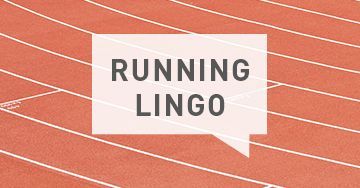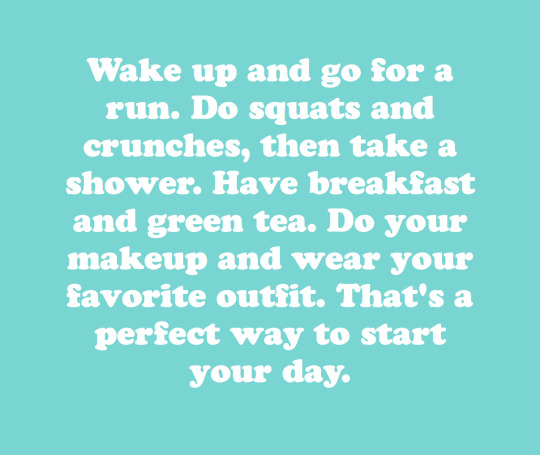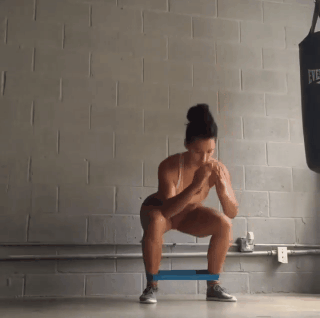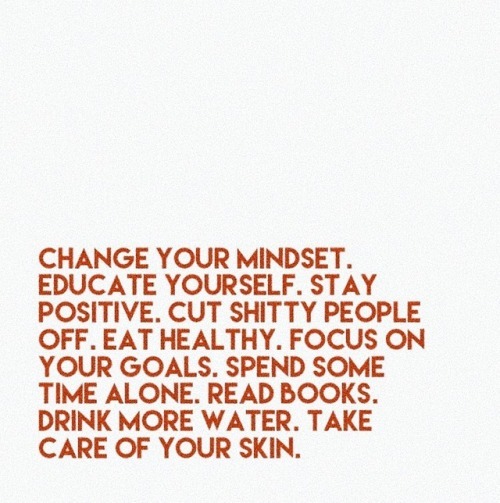motivation for my future beach bod and the ability to kick any ass I wantBrenna. 20. Melbourne FL -> Clemson SC. Vegan. Weightlifter.
Don't wanna be here? Send us removal request.
Video
instagram
Decline ABS!! This made me sore for a WEEK haha (good sore) I did 15-20 reps per exercise for 4 rounds with 100 skips in between! You can change the reps to suit YOU ✅✅☀️ www.kaylaitsines.com/app
315 notes
·
View notes
Text
You can’t rush something you want to last forever.
6K notes
·
View notes
Text
Tomorrow when you’re running, remember to be thankful. Thankful that you have strong legs and lungs and arms and a crazy strong heart and a strong willpower to move and challenge yourself in this beautiful, insane way.
13K notes
·
View notes
Photo

You have to try this combo it’s so good 😍 oats cooked in oatmilk, vanilla, some sweetener topped with coconut yogurt (i use aplro), warm raspberries, banana and peanutbutter ❤
2K notes
·
View notes
Text
Now is a really good time to do what you said you’d do.
6K notes
·
View notes
Text
yoga for a strong core by tara stiles (6 mins)
intense core yoga by gymra (30 mins)(i cannot express how much this killed me)
open hips routine by tara stiles (10 mins)
156 notes
·
View notes
Photo

Because, let’s face it, sometimes even us runners don’t know what we’re talking about!
Basic Running Lingo:
Pace: usually refers to the amount of time it takes to clock one mile. Can also be used to express pace based on the type of run: “long run pace,” “marathon pace,” “5K pace,” etc.
Warm-Up: increasing heart rate and blood flow to the muscles and reduces the risk of injury, prior to a run.
Achilles tendon: The tendon that attaches your calf muscles to your heel bone. Achilles tendinitis can occur in new runners who increase their distance and/or intensity too quickly. Good flexibility in your calves and ankles can help to take some of the load off the Achilles tendon.
Cool-Down: Just as a warm-up preps the body, a cool-down transitions it back to a resting state. Usually involves slowing down with a series of lighter activity and exercise post-workout.
Static Stretching: holding major muscle groups in their most lengthened positions for at least 30 seconds. While many still believe static stretches prior to running help prevent injuries, research now suggests stretching it out is more beneficial afterbreaking a sweat.
Dynamic Stretching: controlled movements that increase flexibility, power, and range of motion. The best dynamic stretches for runners include lunges, squats, leg lifts, and butt-kicks.
Strides: These are simply the forward steps taken while running. Some runners also use strides to refer to a series of short sprints, usually between 50 and 200 meters.
Cadence: the number of steps taken per minute while running.
Dreadmill: The treadmill, ‘nuff said.
Trail Running: running on a trail, which offers a more natural setting, breaks up monotony, and can even work a whole different set of running muscles.
Barefoot Running: Many modern runners are ditching their sneaks and discovering proper running form thanks to the barefoot movement. Made especially trendy by the book Born to Run, it emphasizes running like our cavemen ancestors may also help prevent injuries and improve performance.
Types of Runners:
Newbie: A newbie, or beginner, often learns the basics of the sport by training for a short race, like a 5K. The “Couch-to-5K” training plan is a great place to start!
Streaker: Keeping their clothes on(usually!), a streaker is a runner who runs consecutively every day for an extended period of time.
Ultra marathoner: These totally badass runners, like Dean Karnazes, take on any distance longer than 26.2 miles. Ultramarathons are typically 50K, 100K, 50 miles, or 100 miles.
Elite: Yup, we’re talking about the pros. No matter the distance, elite runners are fast. Really, really fast.
Triathlete: These overachievers not only run, they swim and bike, too.
Running Workout Lingo:
Altitude training: training at altitude to increase the number of red blood cells, improving oxygen delivery to the muscles. Runners find they can train harder and perform better for several weeks after they return from about a month-long stay at altitude. Dehydration can occur at altitude because the air is thinner and dryer, so drink plenty of fluids. Get plenty of rest, and allow a few weeks back at lower altitudes before you race again.
Aquajogging: Running against the water’s resistance in the deep end of a pool, where you can’t touch the bottom, provides many of the benefits of running on land. A flotation belt will help keep you upright and give you stability.
Easy Run: These light runs are best done at a conversational pace. Meaning if you can’t run and carry on a conversation, you’re going too fast!
LSD: the acronym stands for long slow distance, or the week’s longest run.
Recovery Run: a short, slow run that takes place within a day after a long, harder run. This teaches the body how to work through a fatigued state
Speedwork: Aimed at improving running speed, these types of workouts can include intervals, hill repeats, and tempo runs.
Interval Training: alternating specific time periods of specific high and low intensity during a run
Hill Repeats: Running up the hill (again and again) in this other cruel form of speedwork. Heading up at a 5K pace and recovering down at an easy jog or walk, the number of hill repeats per workout depends on experience and fitness levels. But the benefits from the pain? Speed, strength, and confidence!
Fartleks: an easier form of speedwork for beginners. Meaning “speed play” in Swedish, fartleks are easy runs broken up by quick sprinting bursts. When changing speed though, the runner calls the shots (unlike more rigid intervals). So newbies can make it as fast and as hard as they can handle.
Tempo Run: tempo runs are a tougher form of speed training. Runners challenge themselves to hold a “threshold” (or comfortably hard) pace for a 20-minute period during a run—along with a good warm-up and cool down, of course.
Out-and-back: A course that entails running out to a turnaround spot, then running back to the starting point. Out-and-backs are a convenient way to get in runs in unfamiliar locales. They’re also a good option when you’re trying to run a little farther than you have before, because you don’t have the option of cutting the run short.
Pick-Ups: Short, gentle increases in speed, or pick-ups, at the end of a run
Plyometrics: Bounding exercises; any jumping exercise in which landing followed by a jump occurs.
Strength Training: Runners need muscles too! Among its many other benefits, strength training, or exercises performed with or without weights (think push-ups, squats, and planks), helps runners become stronger and prevent injuries.
Cross-Training: sports and exercises other than running that improve overall fitness and strength. Great examples of cross-training for runners include cycling, swimming, yoga, water running, and weight training
Rest Day: Choosing the couch over the road at least one day a week allows a runner’s body to recover and repair muscles.
Running Gear Lingo:
Moisture-Wicking Clothing: Non-cotton running attire or technical apparel that keeps sweat away from the body to prevent chafing
Garmin: Many runners rely on this brand or other GPS-enabled sports watches (often way too much) to track distance, pace, heart rate, and more.
Fuel: When going long, runners have to fill up their tank! Running nutrition comes in all kinds of forms, including energy gels (or GUs), chews, bars, and even jelly beans. Others prefer to chomp on pretzels or sugary candies like Swedish Fish! Just remember, it’s important to eat around 100 calories after an hour of running, followed by another 100 calories every 40-45 minutes to replace the glycogen being used.
Fuel Belt: These super cool (read: super nerdy) Velcro-ed belts/fanny packs hold a runner’s snacks, phone, cash, water, Gatorade, and any other life-or-death accessories.
Orthotics: Devices worn inside running shoes to help treat or prevent injuries. Orthotics can be hard or soft, and of varying length, depending on what injury they’re trying to address. You should wear orthotics only if advised to by a sports medicine professional who says you need one to address a specific underlying imbalance or weakness.
Running Tights: Especially during cold weather months, runners (even men!) squeeze into these spandex leggings or capris to keep warm.
Compression Socks: Often a post-run tradition, runners don a pair of compression socks, or very snug, knee-high tube socks, to speed recovery. Some even wear them during the race itself, believing they get oxygen to the leg muscles at a faster rate.
Minimalist Shoes: These popular lightweight running “shoes” are for runners who want to try barefoot running, without taking it all off.
Singlets: Runners often wear these sleeveless tank tops while racing. Relax! Unlike a wrestling singlet, it’s just a shirt.
Science-y Running Lingo:
Pronation: This refers to the way the foot strikes the ground while running. If someone is an overpronator, their foot rolls inward while running (guilty!). If someone has excessive wear on the outside of their sneakers, they’re likely an underpronator. Getting fitted for a proper running shoe can help with correcting both.
BPM: The heart rate or beats per minute (BPM) is the number of heartbeats during a minute.
Endurance: the body’s ability to withstand stress and pain during an aerobic activity such as running.
Aerobic vs. Anaerobic Exercise: While both aerobic and anaerobic exercises burn glucose, there are some differences. Aerobic exercise is long in duration but low in intensity (like walking or jogging), while anaerobic exercise is short in duration but high in intensity (like sprinting or heavy lifting).
Glycogen: the body stores glucose in the form of glycogen to be used for energy. When glycogen is gone, runners often “hit the wall” (more on that down below).
Heat index: A combined measurement of temperature and humidity that shows how hot it feels outside. When humidity is high, it cripples the body’s ability to sweat—the body’s self-cooling mechanism—so the body retains more heat and it’s riskier to be outside. High humidity also increases the risk for conditions like heat cramps, heat exhaustion, and heatstroke. The National Weather Service issues an alert when the heat index is expected to exceed 105 to 110 degrees Fahrenheit for at least two consecutive days.
Lactic Acid: Formed when the body cannot generate energy using oxygen, lactic acid is produced anaerobically (especially during hard workouts).
Anaerobic Threshold: This is the point of exercise where the going gets tough, and lactic acid begins to accumulate in the bloodstream.
VO2 Max: Also known as aerobic capacity, VO2 Max is the body’s maximum oxygen intake.
Chafing: Yikes. Sweat and fabric rub against the skin while distance running and can cause painful irritation and rashes. To prevent chafing (or worse, bloody nipples), coat up everywhere (and we mean everywhere) with Bodyglide or Vaseline before hitting the road.
Black Toenails: A runner’s badge of honor, or just plain gross? You decide. Discolored toenails on runners are a result of impact and pressure on the toe. Sometimes if you’re lucky, they fall completely off, too!
DOMS: delayed-onset muscle soreness, can occur between 24 and 48 hours after running and can make walking up and down the stairs especially troublesome.
Foam Roller: This tube may look fun and can replace a deep massage in preventing and relieving muscle knots and pain, but it’s also been known to make even the toughest runners whimper.
Runner’s Knee: One of the most common overuse injuries among runners, runner’s knee is also known as Patellofemoral Pain Syndrome (PFPS). The pain is usually isolated on or around the kneecap.
Running Economy: Refers to how much oxygen you use when you run. When you improve your economy, you are able to run at a smaller percentage of max VO2 (your maximum rate of oxygen utilization).
Shin Splints: Another common running injury, shin splints refer to pain on or around the shinbones. Most cases can be treated with rest and ice, but could signal it’s time to whip out the credit card for some new running sneakers.
Plantar Fasciitis: Feel pain and stiffness in the heel? It might be plantar fasciitis or inflammation of the bottom of the foot due to overuse or overstretching. Sufferers can usually self-treat it with rest, ice, and stretching.
ITBS: This painful injury to the IT band in the leg (which runs from the hip, down the thigh, across the knee, and through the shin) can leave many runners (myself included) sidelined. Before totally cursing IT Band Syndrome, massage, stretching, and strength training tend to help. Hey, ITBS, meet the foam roller!
Ice Baths: An ice bath is shocking to the senses, but can also reduce inflammation and aid in the post-long run recovery process.
Overtraining: If the previous injuries didn’t clue you in, there is such a thing as running too much! Let’s refer back to what a “rest day” means, shall we?
Hitting the Wall: Also known as “bonking” during a race, runners will feel as if they can’t go one more step once they “hit the wall.” For many marathoners, the wall shows up around mile 20, and not surprisingly, they usually don’t see it coming.
Race Lingo:
400 Meters: One lap around the track.
Mile: 5280 feet or about 1609 meters (four laps around the track)
5K: 3.14 miles.
10K: 6.28 miles.
Half-Marathon: 13.14 miles.
Marathon: 26.28 (grueling) miles.
Road Race: These public races have a clearly marked course and runners who register to participate—which will usually get them a free T-shirt, too.
Taper: A few weeks before a big race, a runner will decrease their total running mileage to store energy. Because the tapering process involves less running and more rest, runners tend to get very antsy (and hungry) during their taper!
Aid Station: a designated point along the course that offers water and (often) sports drinks to competitors, typically handed out by volunteers. Gells, energy bars, and other items may be offered as well.
Chute: the area immediately past the finish line.
Carbo-Loading: During a taper, runners can eat all the pasta, bread, and bagels they want. Well, not really. There’s a right way and a wrong way to get your carb on!
Bib: Runners pick up this piece of paper with a designated number before the race and attach it to their shirts to wear during the run.
Corral: Because of so many participants, big races often divide runners into groups, with start times based on their expected finishing times. The speedsters at the front; the slowpokes in the back.
Expo: Short for exposition, an assemblage of commercial booths, displays, and (sometimes) informational seminars held in conjunction with a road race, usually in a large hall or convention center. Bib numbers, timing chips, and race packets are typically picked up at a race expo.
Rabbit: Rabbits are runners who serve as pacemakers or pace-setters during a race, with the rest of the field chasing them down. And just like the Energizer Bunny, they keep going, and going, and going—all on pace.
Bandit: These cheaters make their way into a race without registering or paying an entrance fee.
Kick: This is the final push runners give at the end of a race to increase their speed to the finish line.
Chip Time: Often measured by an electronic chip in the sneaker or bib, this is the actual time it takes a runner to get from the start line to the finish line.
Splits: A race’s total time divided into smaller parts (usually miles), is known as the splits. If a runner has an even split, it means they ran the same pace through the entire race. If it’s a negative split, they ran the second half faster than the first. And that’s a good thing!
DNS/DNF: DNS (did not start) or DNF (did not finish) is what will appear in the race results if a runner does not start or finish a race.
PR/PB: These coveted letters stand for personal record and personal best. Good news: Run in just one race and it’s an automatic PR!
BQ: If someone is trying to get a “BQ” or a Boston qualifier, they want to achieve a finish time that gets them entry into the Boston Marathon, the world’s oldest annual marathon and the only one to require a strict qualifying time. For many runners, Boston is the ultimate goal.
Hardware: Wear these race medals with pride, then hang them in a place of honor.
Runner’s High: Most runners experience a state of euphoria and pure bliss known as “the runner’s high” either during or after a run. It might just be the reason runners run—and maybe why we’re so crazy, too.
Adapted from: here, here, here and here!
Think of more terms? Send them to me [kickin-asphalt] and I’ll add them! :)
4K notes
·
View notes
Text
Eat clean. Do cardio. Lift weights. Get sleep. Stay positive.
19K notes
·
View notes









